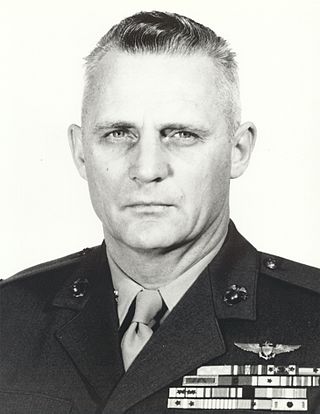
Henry Talmage "Hammerin' Hank" Elrod was a US Marine Corps aviator. He was the first aviator to receive the Medal of Honor during World War II, for his heroism in the defense of Wake Island.
This is a list of aviation-related events from 1918:

Alfred Austell Cunningham was an American aviator and a United States Marine Corps officer who became the first Marine Corps aviator and the first director of Marine Corps Aviation. His military career included service in the Spanish–American War, World War I, and U.S. operations in the Caribbean during the 1920s.

Brigadier General Robert Edward Galer was a naval aviator in the United States Marine Corps who received the Medal of Honor for heroism in aerial combat during the Battle of Guadalcanal in World War II. He went on to command Marine Aircraft Group 12 during the Korean War and retired a few years after in 1957.

Harold William "Joe" Bauer was a United States Marine Corps air group commander, fighter pilot and flying ace credited with destroying 11 Japanese aircraft during World War II. He was posthumously awarded the Medal of Honor for his actions as a fighter squadron commander during the crucial struggle for the control of the Solomon Islands at the Battle of Guadalcanal.

Kenneth Ambrose Walsh was a United States Marine Corps lieutenant colonel and a Medal of Honor recipient who was the fourth ranking USMC fighter ace in World War II with a record of 21 enemy planes destroyed. He also served in Korea during the first year of the Korean War and retired from the Marine Corps in February 1962.

The 94th Aero Squadron was a United States Army Air Service fighter squadron that fought on the Western Front during World War I. The squadron was assigned as a Day Pursuit (Fighter) Squadron as part of the 1st Pursuit Group, First United States Army. Its mission was to engage and clear enemy aircraft from the skies and provide escort to reconnaissance and bombardment squadrons over enemy territory. It also attacked enemy observation balloons and performed close air support and tactical bombing attacks of enemy forces along the front lines.

Robert Guy Robinson was a United States Marine Corps first lieutenant who earned the Medal of Honor as a gunnery sergeant during World War I.

Robert Murray Hanson was a United States Marine Corps flying ace who shot down 25 Japanese planes from the South Pacific skies. He posthumously received the Medal of Honor. One of five children, he is the elder brother of Edith Hanson and Earl Dorchester Hanson.

James Elms Swett was a United States Marine Corps fighter pilot and flying ace during World War II. He was awarded the United States' highest military decoration, the Medal of Honor, for actions while a division flight leader in VMF-221 over Guadalcanal on April 7, 1943. He downed a total of 15.5 enemy aircraft during the war, earning two Distinguished Flying Crosses and five Air Medals.

Erwin Russell Bleckley was a United States Army aviator during World War I, and posthumous recipient of the Medal of Honor, killed in action on October 6, 1918, near the "lost battalion". Bleckley entered service as a member of the Kansas National Guard, was commissioned as an artillery officer, then volunteered for aviation training and duty. His was one of the four Medals of Honor awarded to members of the Air Service in World War I.
Norman Francis Vandivier was a United States Navy aviator during World War II. He was posthumously awarded the Navy Cross for action during the Battle of Midway.

Richard C. Mangrum was a United States Marine Corps lieutenant general who served as Assistant Commandant of the Marine Corps from 1965 to 1967. Mangrum was a Marine Corps aviator who was awarded the Navy Cross and the Distinguished Flying Cross for his actions during the Guadalcanal Campaign in World War II.

The 20th Aero Squadron was a United States Army Air Service unit that fought on the Western Front during World War I.

The 91st Aero Squadron was a unit of the Air Service, United States Army that fought on the Western Front during World War I. The 91st was one of the first five American flying squadrons to reach France, arriving at Chaumont Hill 402 Aerodrome on 15 November 1917.

The 96th Aero Squadron was an Air Service, United States Army unit that fought on the Western Front during World War I.
Captain Jeffery Batters Home-Hay was a Scottish-born Canadian who became a flying ace during World War I. He was a bomber pilot when he was credited with seven aerial victories. He was shot down and captured toward the end of World War I. After being repatriated, he became a pioneering Canadian bush pilot. By the end of his aviation career, he was the oldest pilot still flying in Canada.

The First Army Air Service was an Air Service, United States Army unit that fought on the Western Front during World War I as part of the Air Service, First United States Army. The First Army Air Service was the largest and most diverse Air Service combat organization of the American Expeditionary Forces in France, and most American Air Service combat units were assigned to it when assigned to the front.

Ralph Johnson Mitchell was a decorated aviation officer of the United States. He is most noted for his service as Director of Aviation during the years 1939–1943 and commanding officer of the 1st Marine Aircraft Wing during World War II.

Dumitru-Cicerone Bădulescu was Romania's only World War I ace. Born in Pitești into a family of career soldiers, after graduating from high school he attended the Military School for Infantry Officers and was awarded the rank of Sublocotenent. Like many of the young Romanian officers, Bădulescu felt drawn towards the then-fledgling Aviation Corps and applied for transfer. He got his wish in September 1916, when he was assigned to Grupul 2 Escadrile as an observer.

















